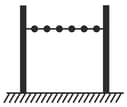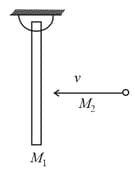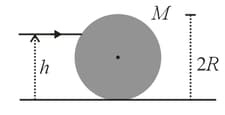Collision of Point Masses with Rigid Bodies
Collision of Point Masses with Rigid Bodies: Overview
This topic covers concepts, such as, Collision between a Ball and a Rod, Collision of a Ball with a Hanging Rod, Collision of a Ball with a Hinged Rod on a Table & Collision of a Ball with a Free Rod on a Smooth Table etc.
Important Questions on Collision of Point Masses with Rigid Bodies
Five identical balls each of mass and radius are strung like beads at random and at rest along a smooth, rigid horizontal thin road of length , mounted between immovable supports. Assume and that the collision between balls or between balls and supports are elastic. If one ball is struck horizontally so as to acquire a speed , the average force felt by the support is

A uniform rod of mass is hinged at its upper end as shown in the figure. A particle of mass which is moving horizontally strikes the rod elastically at its midpoint. If the particle comes to rest after collision, then if the value of what is the value of ?

A bullet of mass is fired horizontally into a large sphere of mass and radius resting on a smooth horizontal table.

The bullet hits the sphere at a height from the table and sticks to its surface. If the sphere starts rolling without slippng immediately on impact, then
A rod of mass and length is lying on a horizontal frictionless surface. A particle of mass travelling along the surface hits the end of the rod with a velocity in a direction perpendicular to . The collision is perfectly elastic and after the collision, the particle comes to rest. The ratio is
A uniform rod of mass and length lies at rest on a smooth horizontal table. A perfectly elastic particle of same mass , moving with speed on the table in a direction perpendicular to the rod, strikes one end of the rod. The kinetic energy generated in the rod is
A uniform road AB of length L and mass M is lying on a smooth table. A small particle of mass m strikes the rod with a velocity v0 at point C a distance x from the ccentre O. The particle comes to rest after collision. The value of x, so that point A of the rod remains stationary just after collision is

